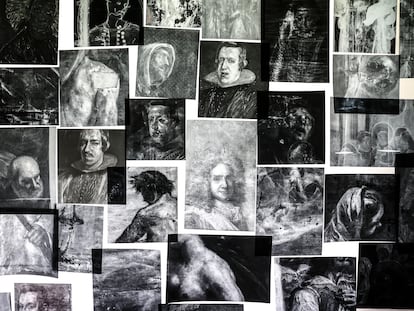The odyssey of the Spanish woman who founded the first public school for girls in Mexico
A historic novel by first-time author Margari Alonso tells the story of María Azlor, who left her life of opulence to become a nun and start an educational facility open to the underprivileged classes

María Ignacia Azlor y Echeverz is well-known in Mexico, while in Spain she is unknown. Born in Mexico in 1715, she had family roots going back to Spain’s northern regions of Navarre (on her mother’s side) and Aragón, and belonged to one of the richest families of the New Spain viceroyalty. The most remarkable event in her life was her renunciation of opulence and comfort to become a nun and dedicate herself to the education of girls, including Indigenous girls, with the founding of the first religious public school for women in Mexico.
To achieve that feat, Azlor had to cross the Atlantic Ocean two times, the first to put her family’s affairs in order in Spain, and the second to return with 11 women who had joined her cause.
Magari Alonso, a native of Navarre who has a law degree, has made her debut as a writer with the entertaining historic novel María Azlor. Una vida entre las dos Españas [María Azlor. A life between the two Spains] (Círculo Rojo). The book is full of dates, characters (everyone alluded to in the book actually existed) and facts, catalogued in the edition’s numerous references. The idea for the book came from a late 18th-century manuscript that Alonso found in the National Library of Spain, about a dozen women who had traveled from Tudela (Navarre) to the Americas to found a school in Mexico. Following this thread, she found more documents, in addition to the women’s boarding tickets.
The information that Alonso gathered for her book is the result of a years’-long investigation in the National Library of Mexico, in the Archive of the Indies, in churches … Of her biographee, Alonso emphasizes that “she wanted to replace charity with education, that poor girls should have access to schooling, she was ahead of her times during the Enlightenment.”
The adventuresome life of Azlor brings the book’s storyline through Mexico City, Havana, Cádiz, Seville, Madrid, Tudela, down the dusty roads that crisscrossed Spain and onto the Carrera de Indias fleet. The text touches on the obstacles that were placed in the way of her wishes, including by some of her family members, who saw it as a crazy undertaking and wanted María to marry well. Once they saw that it was impossible to dissuade her, they tried to convince her to at least build her dream in Spain, rather than Mexico. But in a way, the author writes, Azlor wanted to return to the Americas with the riches that the New World had given her family.
Azlor’s determination was strengthened after losing her parents, and by the marriage of her sister. At only 21 years of age, she embarked from Veracruz in May of 1737, bound for Spain despite the danger of pirate attacks, among other risks. This is the central storyline of the book, that exhausting voyage, marked by death, by a young girl who had barely ever left her family’s estate. The ship arrives in Cádiz at the end of August of the same year, at which point she makes the long journey by carriage to Tudela.
In the Navarrese town, she enters a convent, where she spends 10 years (!) in a humble cell. Azlor wrote to King Ferdinand VI to assure the viability of the future school-convent, which was to be financed by his mines, cattle, jewels, previous stones and money (to which the queen, Barbara de Braganza, contributed.) Bureaucratic drag meant that the royal decree authorizing her project would not arrive until April of 1752. The monarch ordered that she be given “all the favor, aid and assistance needed for this purpose.”
Now all that was left was to simply return to the Americas, accompanied by 11 nuns that she had managed to recruit. In June 1753, they set sail from Cádiz; in the case of our protagonist, this marked a return to the sea after 16 years. Once on Mexican lands, they did not find the road easy, given the misgivings of the bishop’s office.
At last, in June of 1754, the construction of the school-convent began, with cells for the nuns, a health clinic, bathrooms, classrooms and housing for students. In November, the educational facility for girls of varying social classes and skin color became a reality. María Azlor enjoyed her achievement until 1767, when she died at the age of 52. Her initiative continued and spread to other locations throughout the Americas. Another lasting impact was made by her attempt, as Margari Alonso puts it, to “change the role of women in the society of the viceroyalty.”
Sign up for our weekly newsletter to get more English-language news coverage from EL PAÍS USA Edition
Tu suscripción se está usando en otro dispositivo
¿Quieres añadir otro usuario a tu suscripción?
Si continúas leyendo en este dispositivo, no se podrá leer en el otro.
FlechaTu suscripción se está usando en otro dispositivo y solo puedes acceder a EL PAÍS desde un dispositivo a la vez.
Si quieres compartir tu cuenta, cambia tu suscripción a la modalidad Premium, así podrás añadir otro usuario. Cada uno accederá con su propia cuenta de email, lo que os permitirá personalizar vuestra experiencia en EL PAÍS.
¿Tienes una suscripción de empresa? Accede aquí para contratar más cuentas.
En el caso de no saber quién está usando tu cuenta, te recomendamos cambiar tu contraseña aquí.
Si decides continuar compartiendo tu cuenta, este mensaje se mostrará en tu dispositivo y en el de la otra persona que está usando tu cuenta de forma indefinida, afectando a tu experiencia de lectura. Puedes consultar aquí los términos y condiciones de la suscripción digital.
More information
Últimas noticias
Maduro pleads not guilty before the federal court in New York: ‘I am still the president of Venezuela’
A new test can detect Alzheimer’s from a finger prick
UN team enters Sudanese city of El Fasher after paramilitary massacre: ‘It’s like a ghost town’
A recipe for resistance: Indigenous peoples politicize their struggles from the kitchen
Most viewed
- Gilles Lipovetsky: ‘If you want to live better and fall in love, take Prozac, don’t look to philosophy’
- Alain Aspect, Nobel laureate in physics: ‘Einstein was so smart that he would have had to recognize quantum entanglement’
- Alvin Hellerstein, a 92-year-old judge appointed by Bill Clinton, to preside over Maduro’s trial in New York
- Why oil has been at the center of Venezuela-US conflicts for decades
- Maduro’s downfall puts China’s relationship with Venezuela to the test











































